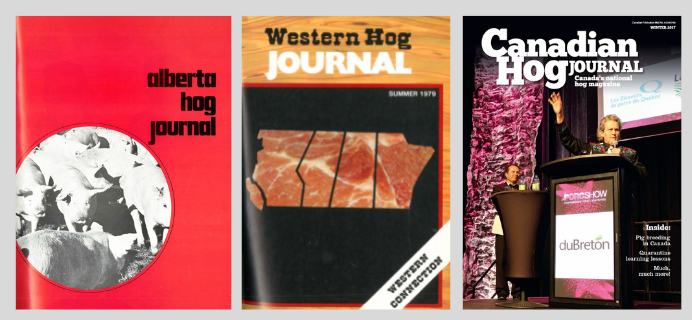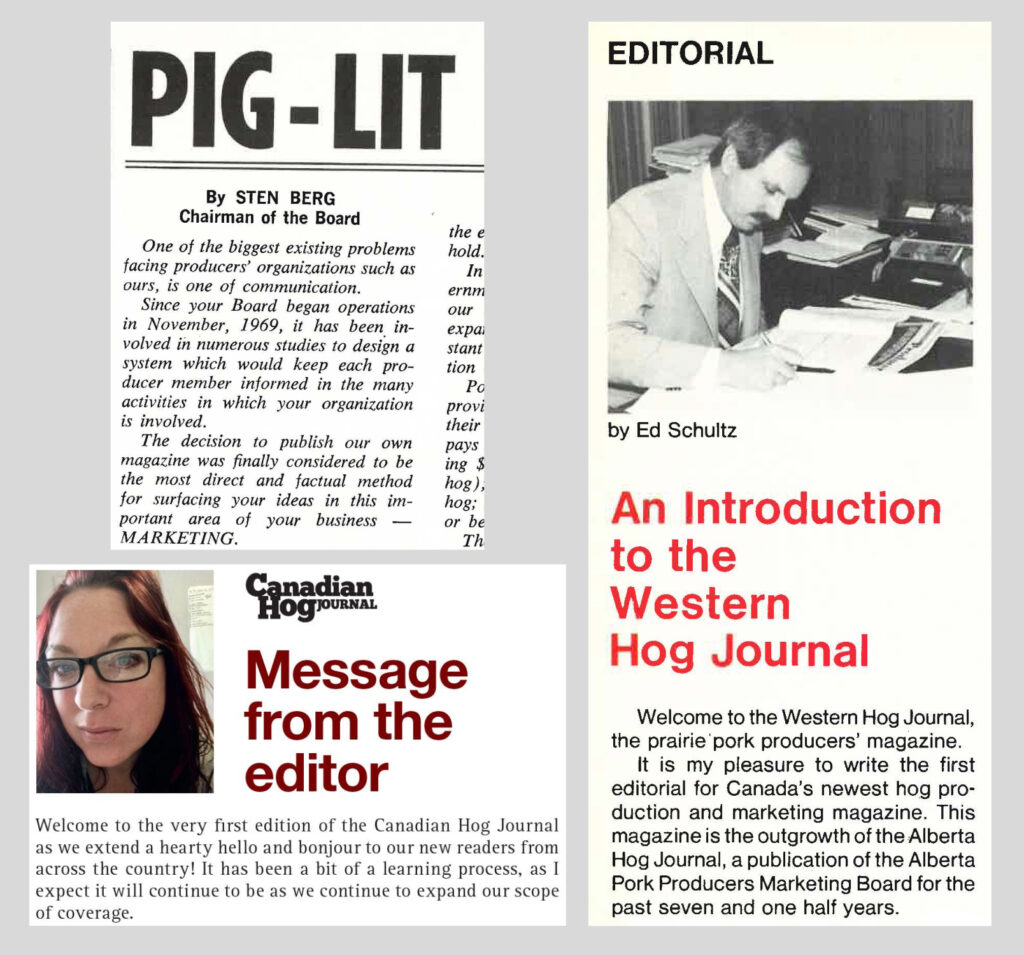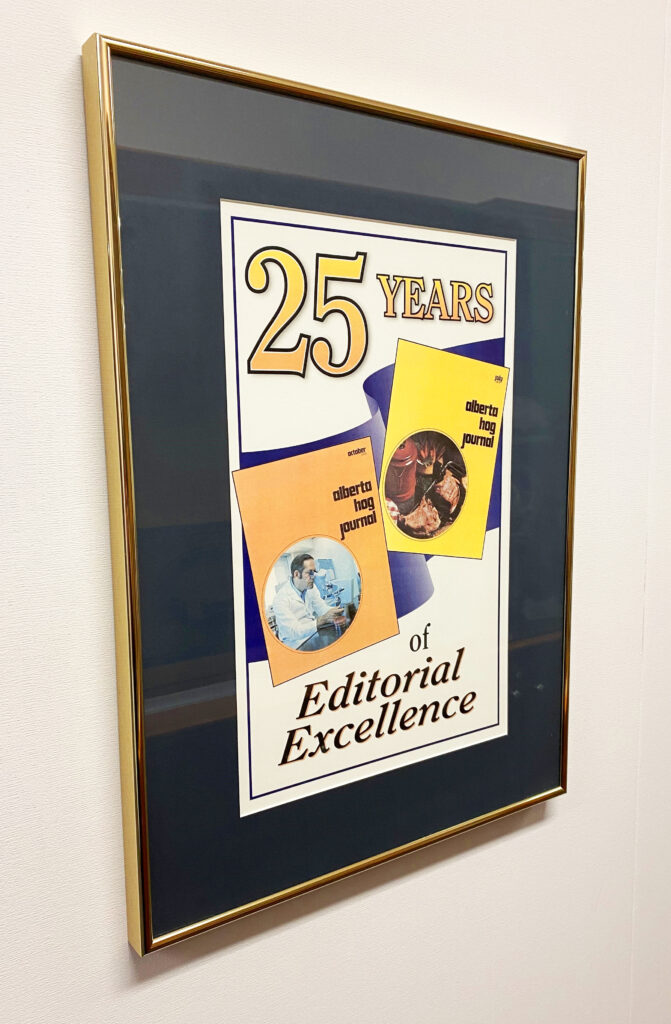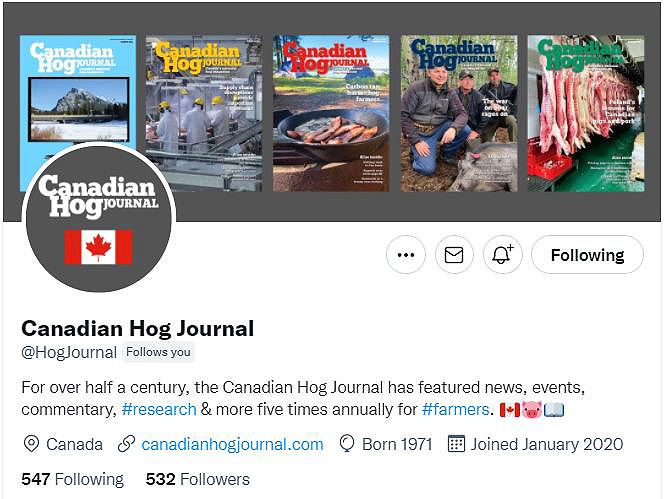By Andrew Heck

The past half-century has brought massive changes to the Canadian pork industry. Changes in politics, society and technology have re-shaped the world in significant ways since 1971, but one thing remains the same in 2022: farmers’ dedication to producing food for consumers, providing jobs for workers and bringing benefits to the economy.
This year, the Canadian Hog Journal celebrates 50 years of publishing coverage of the news, events, commentary, research and other topics that are relevant to farmers, packers, vets, genetics companies, nutrition suppliers, equipment manufacturers and so many people who make this industry what it is.
“When the Alberta Hog Journal first came out, it was my fifth year in the industry, making me one of 22,000 Alberta producers, according to the third edition that year. Three decades later, when I quit hog production, the number of producers had fallen to below 1,000,” said Roy Barrett, a retired farmer near Ponoka, Alberta – approximately 100 kilometres south of Edmonton. “Sten Berg, who was the chair of Alberta Pork at the time, stated in the first edition of the magazine, ‘We believe that primary production belongs in the hands of farmers.’ Unfortunately, hog farmers have disappeared like the bees!”
Now in our 51st year, we are constantly looking forward, but a quick trip down memory lane reveals just how closely connected – and just how far away – we are today, compared to our roots.
Editorial excellence always in focus

The Hog Journal was first conceived as the ‘Alberta’ Hog Journal when Ed Schultz, Alberta Pork’s former communications manager, then general manager, was hired to take the reins of an upstart publication aimed at the provincial hog industry.
Schultz was attending a meeting hosted by Bruce Jeffery, Alberta Pork’s general manager at that time, who had set his sights on expanding Canadian pork access in Japan. Schultz recalls the incident fondly.
“Bruce asked, ‘Can you write?’ And I lied and told him, ‘Yes,’” said Schultz, jokingly.
Thanks to ongoing market development efforts, the valued relationships established back then are still going strong, with Japanese buyers enthusiastic about Canadian pork to this day. The Alberta Hog Journal helped demonstrate to our foreign partners that Canadian pork was a cut above the rest, from swine research to market analysis, leading to the rapid growth of the commercial industry.
After Stirling McLeod edited the very first edition of the Alberta Hog Journal – his only edition – Schultz would take the editorial lead for the next eight years, before turning over the keys to Bill Owen, in 1979, with the re-named ‘Western’ Hog Journal. In that time, Schultz had assumed the general manager position with Alberta Pork, and the magazine duties had become too much. Now operating with the cooperation of producer organizations in B.C., Saskatchewan and Manitoba, the magazine’s popularity and reach had blossomed, further amplifying messages.
Owen would prove to be a stalwart for the next decade, carrying the Western Hog Journal all the way until 1992, when Ward Toma took over.
“The greatest strength of the Journal has always been that it offers very good technical facts,” said Toma. “It is trusted by producers and is well regarded by advertisers, at the same time.”

Toma’s wife, Julie, actually worked with Owen on the magazine at the time the pair met. Toma served as the magazine’s editor until 1996, before joining the Western Hog Exchange (WHE), which split from Alberta Pork that same year, when single-desk selling ended in the province. Today, Toma is the general manager of Alberta Canola.
Following Toma, Jody Wacowich joined.
“For the Journal to last 50 years with all the changes that have happened in communications practice speaks volumes of the value it has for the pork industry,” said Wacowich. “This magazine is a special tool to help keep the industry connected and growing even in the most challenging times.”
Wacowich left the magazine in 2007 and is AgSafe Alberta’s executive director today. After Wacowich, the magazine was taken on by the first of two non-staff editors, Bernie Peet. Sheri Monk took over from Peet in 2013, and in 2017, a national focus was adopted for the magazine. Since being renamed the ‘Canadian’ Hog Journal, the scope of content and readers has continued to expand.
In 2019, the editorial duties were brought back in-house when I (Andrew Heck) was offered the opportunity to take on the role. Two-and-a-half years later, the magazine continues to serve the needs of the many industry stakeholders who read it, and we strive to deliver on our value proposition with every edition.
Content contributors play a crucial role

Each edition of the magazine includes a message from the editor, but what about some of the other players who operate behind the scenes for the publication to become a reality? In many cases, content contributors, designers and administrative staff have outlasted the editors to whom they have answered over the years.
When Marvin Salomons joined Alberta’s agriculture ministry as a pork specialist, in 1980, he was approached by Bill Owen and encouraged by the legendary Frank Aherne – Salomons’ graduate school advisor – to solicit research pieces for the magazine. By 1984, Salomons was writing research reviews himself. His most-recent piece, related to farm labour, was published in 2020.
“I believe the Hog Journal can be proud of where it is today. It has been a long haul with many dedicated editors, transitions and approaches to industry topics,” said Salomons. “Unlike some other magazines, and despite the rise of the internet, the Journal has survived.”
Other writers, such as Geoff Geddes, have also become prolific and regular contributors. Their bylines can be found at the top of many articles published in the past decade.
“The Hog Journal is known as a great place to find important information about the industry,” said Geddes. “With so many interesting topics to pursue, there is no shortage of things to cover.”
Not only editors and writers, but graphic designers, advertising salespeople and Alberta Pork support staff have always been unsung heroes of publishing the Journal.
Prior to the magazine’s ‘Western’ evolution, advertising sales were handled in-house by various Alberta Pork staff members. Starting in 1979, James Shaw, based in Ontario, was responsible for the advertising, until 2014. With Shaw’s departure, sales became the responsibility of Sheri Monk. Following Monk, Robert Samletzki of Calgary-based WTR Media took on the file.
“We’re grateful for advertisers’ support,” said Samletzki. “Their contributions are fundamental to keeping the magazine running, and we appreciate that.”
On the layout side, the Journal was produced by Quality Color Press in Edmonton for many years. Starting in 2010, Capital Colour in Edmonton – just around the corner from the Alberta Pork office – took over design and printing.
“For the last 12 years, we have enjoyed working with the fine people at Alberta Pork,” said Brian Todd, President, Capital Colour. “We’re looking forward to continuing our relationship for many years to come!”
Last but far from least, Marilyn Griesheimer, Office & Finance Manager, Alberta Pork, has been responsible for handling most of the financial demands that come with the magazine, since 1977. At this point, Griesheimer holds the title of the longest-serving member of the team, surpassing Ed Schultz, who retired from the magazine and his lengthy career, in 2007.
The Journal lives on, thanks to you

Fifty years from the inception of the Alberta Hog Journal, few producers today were in business at the time the magazine was first published, but many of their parents and grandparents were. Now, as many of those producers are parents and grandparents themselves, the longevity and sustainability of the family farm and the farming community at large remains at the heart of the Canadian Hog Journal. The printed magazine is still delivered to more than 2,500 mailboxes five times every year, and it is being read digitally by thousands more as time goes on and preferences change.
Through thick and thin, the Journal has withstood a test of time many magazines are never able to achieve. This legacy is the result of much hard work by everyone who has contributed to the magazine, including financially, which is all made possible thanks to the support of producers and the broader industry.
On behalf of the Canadian Hog Journal and Alberta Pork, I would like to offer my sincere thanks to all the readers, advertisers and partners within industry, government and academia who have willingly and faithfully propped up this publication throughout the years – some of which were not particularly easy. Since the beginning, this magazine has existed to encourage the collective success of the entire Canadian pork value chain. This objective has remained firmly front-and-centre for editors past and present, and it will remain in sight for the foreseeable future.





